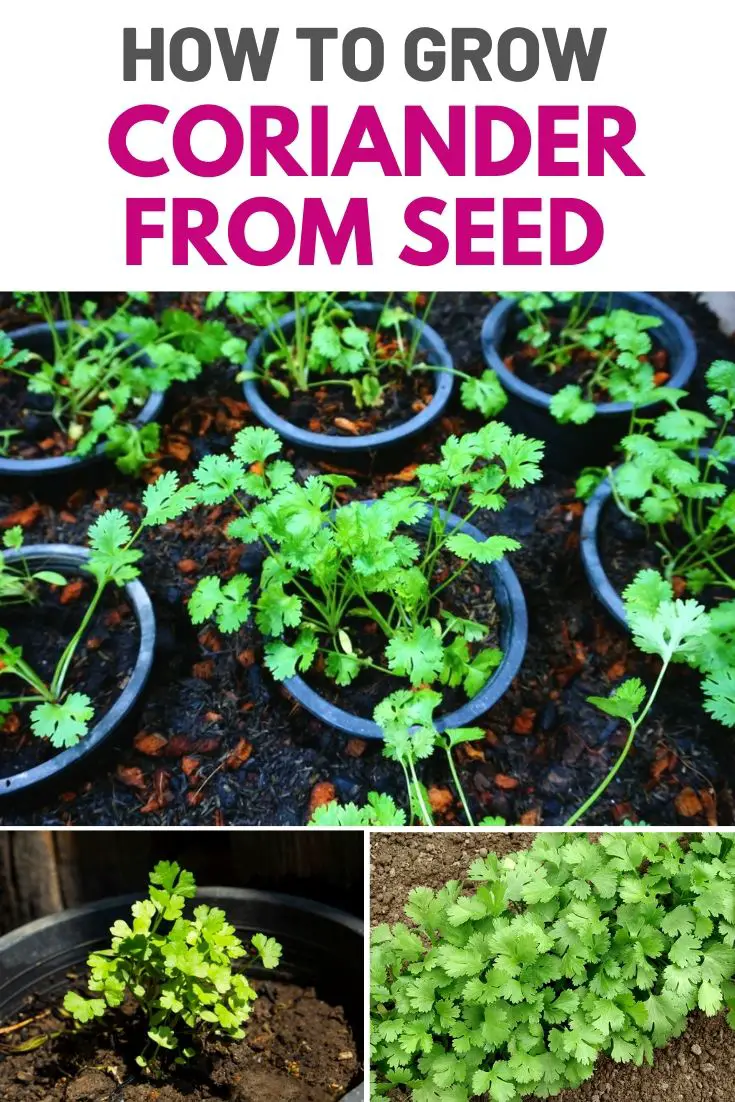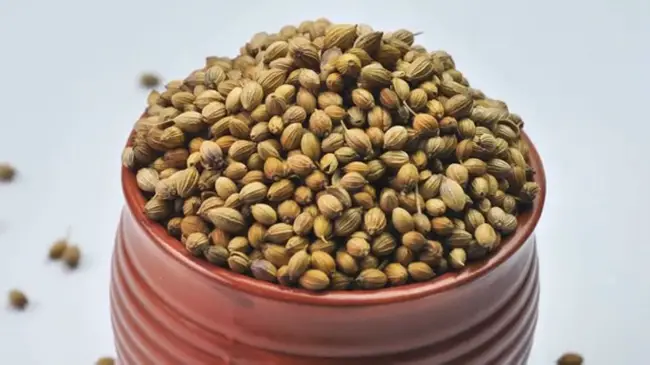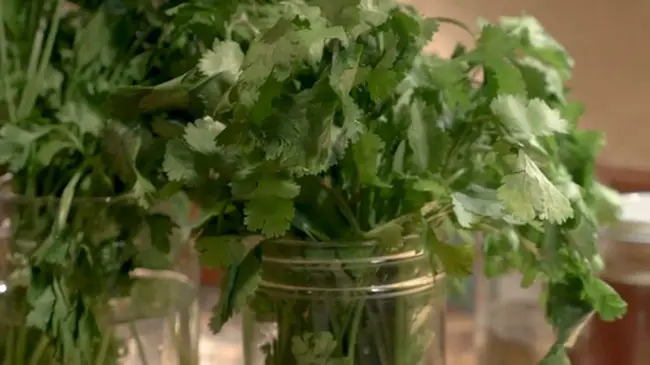Coriander is an annual herb used extensively in Asian cuisine. The fragrant feathery leaves are chopped up and sprinkled over salads, stews, curries, and stir-fries.
The seeds, whole or ground, are used in cooking to add zest to lentils, meat, and vegetable dishes. In some parts of the world, the coriander leaf is known as cilantro. Because coriander is best eaten within a few hours of harvesting, growing coriander at home is a good idea.
This flavorsome and healthy herb is fairly easy to grow in favorable conditions. Given the right temperature, air, soil, and enough water, coriander grows on its own with just a little help in the way of regular watering. Growing coriander on the ground or in large containers gives the best results rather than growing it in small pots since its long taproot needs space.
Coriander does not like extreme heat or cold and will cease to grow in such temperatures. In the tropics, winter is the best time for growing coriander, when the air is dry and cool, while in cooler climates, summer is the right growing season.
What Are Coriander Seeds?
Coriander seeds are one of the most versatile plants used in cooking around the world. But do they really have any special properties that make them unique? Some people insist that coriander has magical healing powers and can even cure cancer, while others argue it’s just an aromatic herb with a rich history. The truth probably lies somewhere in between.
Regardless of its medicinal claims, what we do know is that coriander is incredibly easy to grow from seed – making it a great choice for both the novice and experienced gardener alike. Not only does it require minimal effort to establish, but its fragrant leaves also add flavor to many dishes. So if you’re looking to spruce up your meals with a hint of freshness, then growing coriander could be just the ticket.
Most gardeners recommend growing coriander directly from seed because transplanting stresses this plant, causing it to bolt or go to seed prematurely before the leaves have a chance to develop fully.
While growing coriander, you want to remember that it tends to be sensitive to certain types of stress and bolts easily in extreme weather and when deprived of water.
When Is The Best Time To Grow Coriander?
When it comes to growing coriander, timing is everything. It’s best to sow the seeds in early spring or late summer for optimal growth. If you’re planting indoors, start sowing a few weeks before the last frost of winter. That way, when it’s time to transplant the seedlings into your garden they’ll be ready and raring to go.
It’s important to note that if temperatures get too hot (above 90°F) or too cold (below 40°F), the plant won’t grow as well – so make sure you keep an eye on the forecast. You should also avoid direct sunlight when starting your seedlings; instead, opt for indirect light from a south-facing window or LED lights. And don’t forget about moisture: Keep the soil constantly moist but not waterlogged.
How To Grow Coriander From Seed
Gardening is a labor of love and growing coriander from seed can be an incredibly fulfilling experience. All you need are some seeds, sunlight, water, and soil – the perfect ingredients for success. To get started, take a look at these steps to successfully grow your own delicious coriander.
First off, choose the right type of potting mix or garden bed. Coriander likes well-draining soil that’s rich in organic matter such as composted manure or peat moss. If using pots, aim for something lightweight with good drainage holes so excess moisture doesn’t build up around the roots. Fill the container about two-thirds full with the chosen medium before planting your seeds.
Next, sow your seed directly into the soil. Keep them spaced evenly apart (about 2 inches) and press lightly on top to ensure contact with the moistened dirt below. Then cover over with more soil until only one-fourth of each seed is visible above ground level. Water gently but consistently to keep it damp while waiting for germination which should happen anywhere between 7-14 days depending on conditions like temperature and humidity levels.
In hot weather growing coriander presents some challenges because the plants mature and go to seed in 4 to 6 weeks, therefore it is a good idea to re-sow coriander seeds every three weeks so that you have a regular supply throughout the season.
When ready to harvest, wait until plants have grown to 6 inches high before cutting leaves away near their base – just don’t take too much as this could deplete future harvests. Once done leave what remains standing in place since they will continue flowering and setting new seeds throughout summertime months if given adequate care and attention (watering).
How Long Does It Take To Grow Coriander From Seed?
Gardening can be a long process, and waiting for your herbs to sprout is no exception. Coriander grows fairly quickly from seed—it will take about five days before you’ll start seeing those tiny little leaves popping up from the soil. After that, it should only take a few more weeks of growth before your coriander plants are big enough to harvest. However, there are some things you need to keep in mind when growing this herb:
Make sure the soil temperature is at least 70°F (21°C) or above; secondly, give your coriander plenty of water but don’t let them sit in soggy soil; thirdly, ensure they’re getting enough sunlight each day so they can grow their best. If you do all these things correctly, then within just a few short weeks you’ll have yourself some beautiful fresh-grown coriander.
Should I Soak Coriander Seeds Before Planting?
Soaking coriander seeds before planting is a great way to speed up the germination process. But, do you really need to soak them? That’s the question we’ll be exploring in this section.
The answer is that it depends on what kind of seed you’re using and how long you plan to wait for it to grow. If you have purchased fresh coriander seeds from a reputable seller, then soaking isn’t necessary as they should already be hydrated enough for quick germination. However, if your seeds are older or have been stored for longer periods of time, then soaking can help ensure successful growth.
It is also important to consider the climate where you live when deciding whether or not to soak your coriander seeds. In warmer climates, extra moisture may be beneficial during the early stages of growth; however, in cooler regions with short growing seasons, it might actually delay germination by causing rot due to excess water accumulation around the developing roots. Therefore, if you live in an area with colder temperatures and shorter growing seasons, you may want to skip the pre-soaking step altogether and simply plant dry seeds instead.
No matter which routes you take though – wet or dry – make sure your soil has plenty of organic matter so that your plants can get all the nutrients they need throughout their life cycle.
Is Coriander Easy To Grow From Seed?
Coriander is one of the easiest herbs to grow from seed in the garden. It’s a hardy plant that can tolerate some light frost and grows quickly, with seeds usually sprouting within seven days of sowing. However, its delicate foliage means it needs protection from strong winds and extreme temperatures.
When you’re ready to sow your coriander, choose an area of your garden that gets at least six hours of sunlight each day – more if possible. The soil should be well-drained with plenty of organic matter as compost or manure added beforehand; this will help ensure the roots have adequate drainage while also providing essential nutrients for growth.
Coriander will reach maturity around 70 days after planting, so plan accordingly when timing your sowing session.
How To Care Coriander
Growing coriander from seed is a rewarding experience. In order to get the most out of your harvest, it’s important to provide proper care for this herbaceous plant. With just a few simple steps you can enjoy robust and flavorful leaves all season long.
To start, prepare the soil with compost or aged manure. Coriander likes well-drained soils that are rich in organic matter. Once the soil is prepared, sow seeds directly into the garden bed at least 1/4 inch deep and keep them moist until they germinate.
Once established, watering coriander regularly will help ensure healthy growth and abundant leaf production. Aim to water every 5-7 days depending on weather conditions; make sure not to over-water as soggy soil can lead to fungal diseases like root rot. Additionally, adding mulch around plants helps conserve moisture and control weeds.
For optimal growth and flavor, fertilize your cilantro plants about once a month using either a liquid fertilizer or something slow-release such as fish emulsion or banana peels (yes – really.). Lastly, don’t forget to pinch off flowers when they appear so that energy is directed toward foliage instead of seed production.
How To Harvest Coriander From Cilantro Plants
Harvesting cilantro is a simple process that anyone can do. The first step is to look for the leaves of your coriander plant that have matured, usually about 10-12 weeks after planting. Once you find mature leaves, it’s time to get harvesting. To do this, simply use scissors or kitchen shears to snip off the entire leafy top portion of the plant. Be sure not to cut too low on the stem as this will cause damage and inhibit future growth.
When harvesting coriander from cilantro plants, timing is everything: if you wait too long, the flavor may start to fade and some of the essential oils contained in the leaves may be lost. On the other hand, harvest too soon and they won’t reach full maturity and potency. It’s best to taste test every few days until you find that perfect balance between freshness and flavor intensity.
How To Store Coriander
It’s often thought that storing coriander is a straightforward process, but there are nuances to it. Storing your coriander correctly and for the right amount of time will help ensure you get maximum flavor out of it. Here are some tips on how to store coriander:
- Keep the leaves dry — Moisture can quickly spoil them, so if they come from the grocery store wet with condensation, pat them dry before storage.
- Store in an airtight container — To keep moisture out, use an airtight container or bag to store your fresh herbs.
- Keep away from sunlight — Place your containers in a dark place as light may cause discoloration and make them less flavorful.
- Refrigerate when necessary — If you need to prolong the life of your coriander then refrigeration is key. Keep chilled until ready to be used and remove any wilted leaves prior to using.
- Freeze for long-term storage — Coriander freezes well and can last up to 6 months if frozen properly. Chop the stems finely and freeze them in ice cube trays with water or olive oil for easy use later on.
For best results, try not to wait too long between harvesting and storing your freshly picked bounty of coriander – it’s always best enjoyed soon after picking. And remember, all herbs have different shelf lives depending on their species, so check product labels carefully before purchasing or consuming any store-bought herbs. With proper storage methods, you can confidently enjoy delicious flavorsome dishes made with freshly harvested homegrown coriander.
Read also: 10 Best Garden Crops For Beginners
Did you find this post useful? Would you like to get back to it later? Save THIS PIN below to your gardening or herb garden board on Pinterest! 🙂



